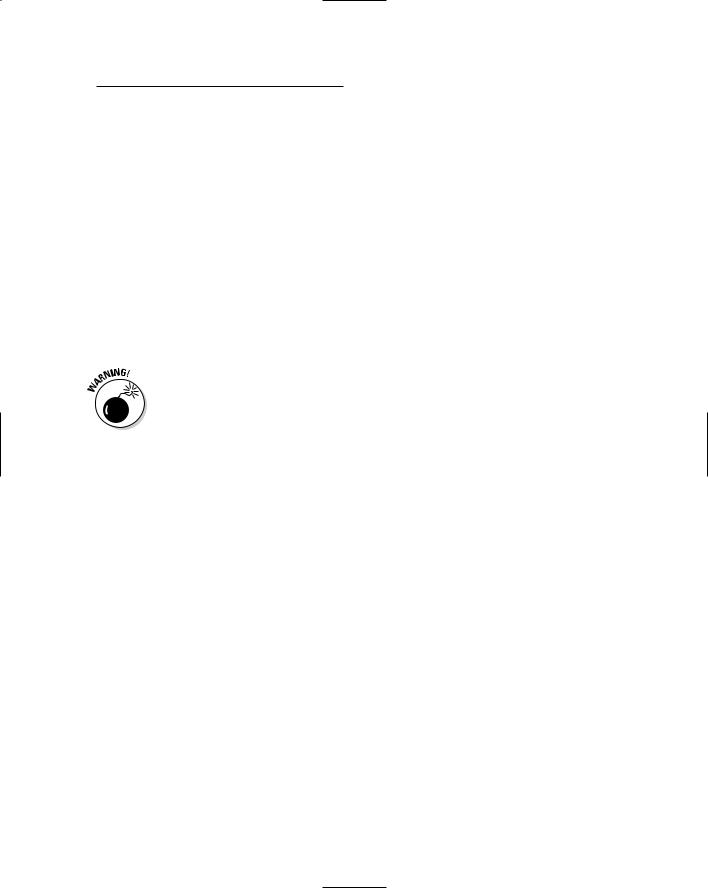
- •Table of Contents
- •Introduction
- •What Is C++?
- •Conventions Used in This Book
- •How This Book Is Organized
- •Part I: Introduction to C++ Programming
- •Part III: Introduction to Classes
- •Part IV: Inheritance
- •Part V: Optional Features
- •Part VI: The Part of Tens
- •Icons Used in This Book
- •Where to Go from Here
- •Grasping C++ Concepts
- •How do I program?
- •Installing Dev-C++
- •Setting the options
- •Creating Your First C++ Program
- •Entering the C++ code
- •Building your program
- •Executing Your Program
- •Dev-C++ is not Windows
- •Dev-C++ help
- •Reviewing the Annotated Program
- •Examining the framework for all C++ programs
- •Clarifying source code with comments
- •Basing programs on C++ statements
- •Writing declarations
- •Generating output
- •Calculating Expressions
- •Storing the results of expression
- •Declaring Variables
- •Declaring Different Types of Variables
- •Reviewing the limitations of integers in C++
- •Solving the truncation problem
- •Looking at the limits of floating-point numbers
- •Declaring Variable Types
- •Types of constants
- •Special characters
- •Are These Calculations Really Logical?
- •Mixed Mode Expressions
- •Performing Simple Binary Arithmetic
- •Decomposing Expressions
- •Determining the Order of Operations
- •Performing Unary Operations
- •Using Assignment Operators
- •Why Mess with Logical Operations?
- •Using the Simple Logical Operators
- •Storing logical values
- •Using logical int variables
- •Be careful performing logical operations on floating-point variables
- •Expressing Binary Numbers
- •The decimal number system
- •Other number systems
- •The binary number system
- •Performing Bitwise Logical Operations
- •The single bit operators
- •Using the bitwise operators
- •A simple test
- •Do something logical with logical calculations
- •Controlling Program Flow with the Branch Commands
- •Executing Loops in a Program
- •Looping while a condition is true
- •Using the for loop
- •Avoiding the dreaded infinite loop
- •Applying special loop controls
- •Nesting Control Commands
- •Switching to a Different Subject?
- •Writing and Using a Function
- •Divide and conquer
- •Understanding the Details of Functions
- •Understanding simple functions
- •Understanding functions with arguments
- •Overloading Function Names
- •Defining Function Prototypes
- •Variable Storage Types
- •Including Include Files
- •Considering the Need for Arrays
- •Using an array
- •Initializing an array
- •Accessing too far into an array
- •Using arrays
- •Defining and using arrays of arrays
- •Using Arrays of Characters
- •Creating an array of characters
- •Creating a string of characters
- •Manipulating Strings with Character
- •String-ing Along Variables
- •Variable Size
- •Address Operators
- •Using Pointer Variables
- •Comparing pointers and houses
- •Using different types of pointers
- •Passing Pointers to Functions
- •Passing by value
- •Passing pointer values
- •Passing by reference
- •Limiting scope
- •Examining the scope problem
- •Providing a solution using the heap
- •Defining Operations on Pointer Variables
- •Re-examining arrays in light of pointer variables
- •Applying operators to the address of an array
- •Expanding pointer operations to a string
- •Justifying pointer-based string manipulation
- •Applying operators to pointer types other than char
- •Contrasting a pointer with an array
- •Declaring and Using Arrays of Pointers
- •Utilizing arrays of character strings
- •Identifying Types of Errors
- •Choosing the WRITE Technique for the Problem
- •Catching bug #1
- •Catching bug #2
- •Calling for the Debugger
- •Defining the debugger
- •Finding commonalities among us
- •Running a test program
- •Single-stepping through a program
- •Abstracting Microwave Ovens
- •Preparing functional nachos
- •Preparing object-oriented nachos
- •Classifying Microwave Ovens
- •Why Classify?
- •Introducing the Class
- •The Format of a Class
- •Accessing the Members of a Class
- •Activating Our Objects
- •Simulating real-world objects
- •Why bother with member functions?
- •Adding a Member Function
- •Creating a member function
- •Naming class members
- •Calling a Member Function
- •Accessing a member function
- •Accessing other members from a member function
- •Defining a Member Function in the Class
- •Keeping a Member Function After Class
- •Overloading Member Functions
- •Defining Arrays of and Pointers to Simple Things
- •Declaring Arrays of Objects
- •Declaring Pointers to Objects
- •Dereferencing an object pointer
- •Pointing toward arrow pointers
- •Passing Objects to Functions
- •Calling a function with an object value
- •Calling a function with an object pointer
- •Calling a function by using the reference operator
- •Returning to the Heap
- •Comparing Pointers to References
- •Linking Up with Linked Lists
- •Performing other operations on a linked list
- •Hooking up with a LinkedListData program
- •A Ray of Hope: A List of Containers Linked to the C++ Library
- •Protecting Members
- •Why you need protected members
- •Discovering how protected members work
- •Protecting the internal state of the class
- •Using a class with a limited interface
- •Creating Objects
- •Using Constructors
- •Why you need constructors
- •Making constructors work
- •Dissecting a Destructor
- •Why you need the destructor
- •Working with destructors
- •Outfitting Constructors with Arguments
- •Justifying constructors
- •Using a constructor
- •Defaulting Default Constructors
- •Constructing Class Members
- •Constructing a complex data member
- •Constructing a constant data member
- •Constructing the Order of Construction
- •Local objects construct in order
- •Static objects construct only once
- •Global objects construct in no particular order
- •Members construct in the order in which they are declared
- •Destructors destruct in the reverse order of the constructors
- •Copying an Object
- •Why you need the copy constructor
- •Using the copy constructor
- •The Automatic Copy Constructor
- •Creating Shallow Copies versus Deep Copies
- •Avoiding temporaries, permanently
- •Defining a Static Member
- •Why you need static members
- •Using static members
- •Referencing static data members
- •Uses for static data members
- •Declaring Static Member Functions
- •What Is This About, Anyway?
- •Do I Need My Inheritance?
- •How Does a Class Inherit?
- •Using a subclass
- •Constructing a subclass
- •Destructing a subclass
- •Having a HAS_A Relationship
- •Why You Need Polymorphism
- •How Polymorphism Works
- •When Is a Virtual Function Not?
- •Considering Virtual Considerations
- •Factoring
- •Implementing Abstract Classes
- •Describing the abstract class concept
- •Making an honest class out of an abstract class
- •Passing abstract classes
- •Factoring C++ Source Code
- •Defining a namespace
- •Implementing Student
- •Implementing an application
- •Project file
- •Creating a project file under Dev-C++
- •Comparing Operators with Functions
- •Inserting a New Operator
- •Overloading the Assignment Operator
- •Protecting the Escape Hatch
- •How Stream I/O Works
- •The fstream Subclasses
- •Reading Directly from a Stream
- •Using the strstream Subclasses
- •Manipulating Manipulators
- •Justifying a New Error Mechanism?
- •Examining the Exception Mechanism
- •What Kinds of Things Can I Throw?
- •Adding Virtual Inheritance
- •Voicing a Contrary Opinion
- •Generalizing a Function into a Template
- •Template Classes
- •Do I Really Need Template Classes?
- •Tips for Using Templates
- •The string Container
- •The list Containers
- •Iterators
- •Using Maps
- •Enabling All Warnings and Error Messages
- •Insisting on Clean Compiles
- •Limiting the Visibility
- •Avoid Overloading Operators
- •Heap Handling
- •Using Exceptions to Handle Errors
- •Avoiding Multiple Inheritance
- •Customize Editor Settings to Your Taste
- •Highlight Matching Braces/Parentheses
- •Enable Exception Handling
- •Include Debugging Information (Sometimes)
- •Create a Project File
- •Customize the Help Menu
- •Reset Breakpoints after Editing the File
- •Avoid Illegal Filenames
- •Include #include Files in Your Project
- •Executing the Profiler
- •System Requirements
- •Using the CD with Microsoft Windows
- •Using the CD with Linux
- •Development tools
- •Program source code
- •Index

Chapter 1: Writing Your First C++ Program |
21 |
The message Press any key gives you the opportunity to read what you’ve entered before it goes away. Press Enter, and the window (along with its con tents) disappears. Congratulations! You just entered, built, and executed your first C++ program.
Dev-C++ is not Windows
Notice that Dev-C++ is not truly intended for developing Windows programs. In theory, you can write a Windows application by using Dev-C++, but it isn’t easy. (That’s so much easier in Visual Studio.NET.)
Windows programs show the user a very visually oriented output, all nicely arranged in onscreen windows. Convesion.exe is a 32-bit program that exe cutes under Windows, but it’s not a “Windows” program in the visual sense.
If you don’t know what 32-bit program means, don’t worry about it. As I said earlier, this book isn’t about writing Windows programs. The C++ programs you write in this book have a command line interface executing within an MS DOS box.
Budding Windows programmers shouldn’t despair — you didn’t waste your money. Learning C++ is a prerequisite to writing Windows programs. I think that they should be mastered separately: C++ first, Windows second.
Dev-C++ help
Dev-C++ provides a Help menu item. Choose Help followed by Help on Dev C++ to open up a typical Windows help box. Help is provided on various aspects of the Dev-C++ development package but not much else. Noticeably lacking is help on the C++ language itself. Click a topic of interest to display help.
Reviewing the Annotated Program
Entering data in someone else’s program is about as exciting as watching some one else drive a car. You really need to get behind the wheel itself. Programs are a bit like cars as well. All cars are basically the same with small differences and additions — OK, French cars are a lot different than other cars, but the point is still valid. Cars follow the same basic pattern — steering wheel in front of you, seat below you, roof above you and stuff like that.

22 |
Part I: Introduction to C++ Programming |
Similarly, all C++ programs follow a common pattern. This pattern is already present in this very first program. We can review the Conversion program by looking for the elements that are common to all programs.
Examining the framework for all C++ programs
Every C++ program you write for this book uses the same basic framework, which looks a lot like this:
//
//Template - provides a template to be used as the starting
//point
//
//the following include files define the majority of
//functions that any given program will need #include <cstdio>
#include <cstdlib> #include <iostream> using namespace std;
int main(int nNumberofArgs, char* pszArgs[])
{
//your C++ code starts here
//wait until user is ready before terminating program
//to allow the user to see the program results system(“PAUSE”);
return 0;
}
Without going into all the boring details, execution begins with the code con tained in the open and closed braces immediately following the line begin ning main().
I have copied this code into a file called Template.cpp located in the main CPP_Programs folder on the enclosed CD-ROM.
Clarifying source code with comments
The first few lines in Conversion.cpp appear to be freeform text. Either this code was meant for human eyes or C++ is a lot smarter than I give it credit for. These first six lines are known as comments. Comments are the programmer’s

Chapter 1: Writing Your First C++ Program |
23 |
explanation of what he or she is doing or thinking when writing a particular code segment. The compiler ignores comments. Programmers (good program mers, anyway) don’t.
A C++ comment begins with a double slash (//) and ends with a newline. You can put any character you want in a comment. A comment may be as long as you want, but it’s customary to keep comment lines to no more than 80 char acters across. Back in the old days — “old” is relative here — screens were limited to 80 characters in width. Some printers still default to 80 characters across when printing text. These days, keeping a single line to under 80 char acters is just a good practical idea (easier to read, less likely to cause eye strain, the usual).
A newline was known as a carriage return back in the days of typewriters — when the act of entering characters into a machine was called typing and not keyboarding. A newline is the character that terminates a command line.
C++ allows a second form of comment in which everything appearing after a /* and before a */ is ignored; however, this form of comment isn’t normally used in C++ anymore. (Later in this book, I describe the one case in which this type of comment is applied.)
It may seem odd to have a command in C++ (or any other programming lan guage) that’s specifically ignored by the computer. However, all computer lan guages have some version of the comment. It’s critical that the programmer explain what was going through her mind when she wrote the code. A programmer’s thoughts may not be obvious to the next colleague who picks up her program and tries to use it or modify it. In fact, the programmer herself may forget what her program meant if she looks at it months after writing the original code and has left no clue.
Basing programs on C++ statements
All C++ programs are based on what are known as C++ statements. This sec tion reviews the statements that make up the program framework used by the Conversion.cpp program.
A statement is a single set of commands. All statements other than comments end with a semicolon. (There’s a reason that comments don’t end with a semicolon, but it’s obscure. To my mind, comments should end in semicolons as well, for consistency’s sake. Why nobody asked me about that remains a mystery.)

24 |
Part I: Introduction to C++ Programming |
Program execution begins with the first C++ statement after the open brace and continues through the listing, one statement at a time.
As you look through the program, you can see that spaces, tabs, and newlines appear throughout the program. In fact, I place a newline after every state ment in this program. These characters are collectively known as white space because you can’t see them on the monitor.
You may add white space anywhere you like in your program to enhance readability — except in the middle of a word:
See wha
t I mean?
Although C++ may ignore white space, it doesn’t ignore case. In fact, it’s case sensitive to the point of obsession. The variable fullspeed and the variable FullSpeed have nothing to do with each other. While the command int may be understood completely, C++ has no idea what INT means.
Writing declarations
The line int nCelsius; is a declaration statement. A declaration is a state ment that defines a variable. A variable is a “holding tank” for a value of some type. A variable contains a value, such as a number or a character.
The term variable stems from algebra formulae of the following type:
x = 10
y = 3 * x
In the second expression, y is set equal to 3 times x, but what is x? The vari able x acts as a holding tank for a value. In this case, the value of x is 10, but we could have just as well set the value of x to 20 or 30 or –1. The second for mula makes sense no matter what the value of x.
In algebra, you’re allowed to begin with a statement, such as x = 10. In C++, the programmer must first define the variable x before she can use it.
In C++, a variable has a type and a name. The variable defined on Line 11 is called celsius and declared to hold an integer. (Why they couldn’t have just said integer instead of int, I’ll never know. It’s just one of those things you learn to live with.)
